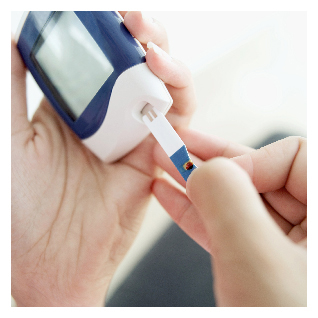Continuous Glucose Monitors
The use of continuous glucose monitoring (CGM) has increased significantly since 2015 due to markedly improved sensor accuracy.
The “brains” of any CGM system is a small sensor wire placed under the skin that measures glucose levels in the surrounding interstitial fluid.
The levels are sent wirelessly to a receiver, attached to a monitor, allowing you to see what your glucose level is, almost in “real time”.
The glucose reading you see isn’t the value at that exact time as interstitial glucose levels lag behind venous blood glucose levels by 5-20 minutes.
Despite the lag, CGM systems provide reliable information regarding glucose trends, as well as feedback regarding the impact of food, stress, and activity.
Glucose targets are set manually, typically at 70-180 mg/dl.
Time spent In the desired range is designated formally as “Time in Range”, or “TIR”.
Ideally, the TIR should be >70%, corresponding to an HA1c of 7% or less.
Glucose targets and TIR can be adjusted in settings such as pregnancy (lower the target to 70-140), the elderly, or those at risk for severe hypoglycemia (reduce the TIR goal to 50%).
With each 10% increase in the TIR, there is a corresponding 0.5% reduction in the HA1c.
Improvements in TIR have been correlated with reductions in the risk of diabetes related complications such as eye disease in several clinical trials.
Glucose levels <70 mg/dl are designated as “Time Below Range” or TBR.
Ideally, <3% of glucose values should be in TBR.
A TBR of 3% corresponds to 43 minutes per day (3% of 1440 minutes) spent at glucose levels <70 mg/dl.
The TBR should always be reviewed, especially if you have a history of hypoglycemia.
Several studies have reported greater impact on average glucose values through use of CGM than with adjusting insulin delivery methods.
I recommend the Dexcom G6 and Freestyle Libre CGM systems most frequently.
Both have been approved by the FDA to use to make insulin adjustments
I don’t prescribe the Medtronic Guardian except when paired with a Medtronic insulin pump due to chronic problems with accuracy.
I don’t use the Eversense because of the twice daily calibration requirement, need for a 24-hour warm up, and the need for surgical insertion and replacement every 3 months.
I like Dexcom’s G6 because: excellent 9% MARD (the average of the absolute error between all CGM values and matched reference values), no need for calibration, high and low glucose alarms, customized alerts, a predictive low function that will warn you if a glucose <55 mg/dl will occur within 20 minutes, iPhone and Android compatibility, user friendly Clarity software, ability to share in real time, a 2-hour warm up, no medication interference, 10 day sensor duration, and windows that provide 1 hour, 3 hour, 12 hour and 24 hour BG overviews.
Sensor placement is approved for the abdomen and upper buttocks. Users also place the sensor on their upper arm.
Sensor accuracy is 83% overall, with 90% accuracy in the hypoglycemic range.
Sensors are programmed for a hard stop at 10 days, which is different from the 7 day G5 sensors which could be re-used.
Remember that given the lag between interstitial and venous blood glucose, the value on your G6 monitor will be ~10-15 minutes "behind" your venous blood glucose. These delays may be most significant with rising glucose levels.
Predictive algorithms shorten the lag to <10 minutes.
Some reasons I don’t like the G6 include insurance denials if not testing 4x daily or using a MDI regimen, the need for transmitter changes, risk of sensor loss due to adhension or, less commonly, trauma, and reduced sensor accuracy after 8 days.
Sensor loss can be reduced by shaving and/or applying alcohol to the insertion site, as well as applying Tegaderm or Skin Tac.
https://www.amazon.com/Skin-TacTM-Adhesive-Barrier-Wipes-count/dp/B002NSCHY4
Although the G6 insertion device is much easier to use than the G5, some may find it intimidating, especially when compared to the Libre.
I recommend the G6 most commonly to people using pumps or mutliple daily injection (MDI) regimens.
The Dexcom G7 was recenlty introduced.
It is smaller than the G6, easier to apply, and somewhat more accurate.
https://www.dexcom.com/en-us/g7-cgm-system
I like Abbott’s Freestyle Libre because: easy insertion, low profile, low price (sensors range from $40-$80), an average daily cost of $4 vs $7-$8 for the G6, a built in BG meter, iPhone and Android compatibility, trend arrows, 14 day sensor duration, a MARD of 9.4%, an estimated lag time of 5 minutes, availability at the pharmacy, less intimidating design/application compared to the G6, and the shortest CGM warm-up at 1 hour.
Using the “flash” system, data is transmitted from the sensor to the reader in 1 second.
Sensor accuracy is 81% overall, but only 53% for hypoglycemia.
Reasons I don’t like the Libre and Libre 2 include the need to scan the sensor every 8 hours to retain data (not an issue with the Libre 3), sensor application limited to the back of the upper arm, no sharing feature, no alerts, sensor inaccuracy at low glucose levels, interference by high dose vitamin C, a viewing window of only 8 hours, and sensor loss due to adhesion or trauma.
I recommend the Libre most frequently, although not exclusively, to people with T2 diabetes.
The Libre 2 has alarm features and bluetooth capabilities.
The Libre 3 is significantly smaller than the Libre 2.
It's also more accurate, and most importantly, doesn't require scanning every 8 hours to retain data.
https://www.freestyle.abbott/us-en/products/freestyle-libre-3.html
Adhesive problems have increased for both CGM’s, presumably due to changes in adhesive manufacturing.
If you're having problems with this, please call me to discuss some potential solutions.
Customer support for both CGM’s has been historically good.
If your experiences have been different with any CGM system, please let me know.
This is a very nice comparison of the G7 and Libre 3 from danatech
https://www.diabeteseducator.org/danatech/glucose-monitoring/continuous-...(cgm)/cgm-selection-training/dexcom-g7-libre-3-comparison


